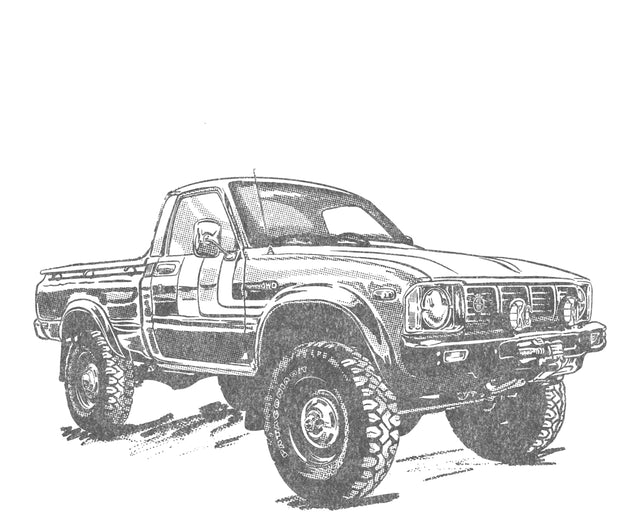Toyota Pick Up
The Toyota Pickup, born of a redesign of the Hilux, was introduced in August 1978 with a 4WD variant introduced in January 1979. The newer model had similar dimensions to its predecessor with added wider front and rear tracks. The front suspension went from coil springs to a torsion bar design, still with a double wishbone layout. The 4WD variant – not offered with any engines smaller than the two-litre "18R" – featured some common technology from the larger Toyota Land Cruiser. Its front axle had a live, leaf-sprung design unlike the more car-like type used on rear-wheel drive Hiluxes. Production of the four-wheel drive models stopped in July 1983, but some 2WD variations continued production alongside the next generation models. The L series diesel engine was offered on the 2WD variants from September 1979 as well as on the 4WD variants beginning in March 1983. In Japan, the Hilux was joined with the Toyota MasterAce.
The 1.6-liter 12R engine originally came in rear-wheel drive models in the Australian market, while 4WD models had the 2-liter 18R-C engine with 63 kW (86 PS). These were all built on the longer wheelbase, with either pickup or cab-chassis bodywork. Top speed of the Australian Hilux 4WD reached 130 km/h (81 mph).
In North American markets, the Hilux was known as the Pickup and came as four-wheel drive. It had a solid front axle and leaf suspension. The redesigned body included single round headlights and a simpler body style. This new 4WD setup featured a gear driven RF1A transfer case. The transfer case is unique in the ability of its low-range reduction portion to be replicated, using what is sometimes referred to as a dual or triple transfer case. This results in a lower overall gear ratio. It was the first Hilux available with an automatic transmission in North America.
In 1981, a vehicle development agreement between Toyota, Winnebago Industries and two aftermarket customizers allowed Toyota to enter the SUV market in North America by way of the Trekker (Winnebago), Wolverine, and the Trailblazer (Griffith). All three used the Hilux 4×4 RV cab and chassis and an all-fiberglass rear section (the Trailblazer had a steel bed with a fiberglass top). Research and development on the Trekker led to the 4Runner/Hilux Surf introduced in 1984.
For the 1983½ model year, Toyota introduced the luxury Mojave trim in the US market as a limited-production (3,500 units) model with options unavailable on other Toyota pickups. It had bucket seats, two-speaker multiplex radio and chrome front and rear bumpers. Cruise control, power steering, and air conditioning came optional. It was powered by the SR5's standard 2.4 L (150 cu in) inline-four engine. In Thailand, this model was sold as the Toyota Hilux Super Star.
Next Generation (1983)
The August 1983 redesign (sold as model year 1984 vehicles in North America) introduced the Xtracab extended cab option, with six inches of space behind the seat for in-cab storage. These models carried over the carbureted 22R engine while model year 1984 also saw the introduction of the fuel injected 22R-E engine. It came with a choice of two diesel engines, the 2L or the turbocharged 2L-T. Demand for higher performance and the wide availability of inexpensive gas caused these engines to be discontinued in the U.S. after the 1986 model year. The next year a turbocharged option, the 22R-TE, debuted. An independent front suspension/torsion bar replaced the solid front axle in the 4×4 model in 1986, with optional automatic differential disconnect for the front differential (an alternative to automatic locking hubs). 1985 became the last year of the 22R motor and the solid front axle in most markets. The solid front axle remained in the 4x4 LN106 model until 1997.
For the 1987 model year, the truck went through a minor interior and exterior redesign. A V6 engine was introduced in 1988. The Hilux-based 4Runner made its entry in Australia, North America and the United Kingdom based on this generation of the Hilux while in some other markets, such as Japan, it was called the Hilux Surf.
Toyota introduced a new generation of the Hilux in most markets in late 1988, but the previous generation remained in production until 1997 in South Africa. In Thailand, this generation was sold as the Toyota Hilux Hero.
The next redesign in 1988 introduced a longer-wheelbase option, 3,099 mm (122 in) rather than 2,616 mm (103 in) for the regular wheelbase. Its one-piece cargo-box walls eliminated the rust-prone seams found in earlier models. The V6 Xtracab SR5 earned Motor Trend magazine's Truck of the Year award that year. The Xtra Cabs featured more room behind the front seats than the previous generation which allowed optional jump-seats for rear passengers, a feature more in line with competitors of the time.
In 1991, North American production began at the NUMMI plant in Fremont, California. The Hilux received a minor facelift for the 1992 model year which included incorporating the new Toyota emblem into the grill.
It was during this generation that Toyota discontinued the Hilux in the United States, replacing it with the Tacoma for the 1995 model year.
North America
In North America the Hilux continued to be sold simply as the "Toyota Pickup". A wide range of models were available (excluding the Crew Cab model available internationally), mixing four- and six-cylinder engines, long and short beds, regular and Xtracabs, manual and automatic transmissions, and two- or four-wheel drive. The cargo capacity was typically 1,640 lb (744 kg) for two-wheel drives and 1,400 lb (635 kg) for four-wheel drive models. GVWRs ranged from 2,565 to 5,350 lb (1,163 to 2,427 kg). Initially only imported from Japan, NUMMI-built trucks began appearing in 1990. The VIN on these trucks starts with '4T', while Japanese-made vehicles begin with 'JT'.
Rig illustration reference credit: @dirtstar2002

